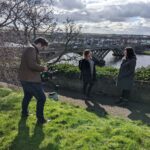We know it’s often hard for people looking for video production to determine how much it will cost. We are also filmmakers, not salespeople, so we don’t want to make anyone pay for more than they need. We want our pricing to be as transparent and fair as possible for all customers to help them get the best possible product within their budget.
That’s why we created our video pricing estimator and why I’m writing this guide to help give an idea of the costs involved so you know what you need to do to get the best value for money.
Very simply the price of a film or series of films depends on how much time is involved and what equipment will be required for:
-
Preproduction (any discussions, planning, scheduling and scriptwriting before a shoot)
-
The Shoot
-
Post Production (any editing, tweaks, graphics and music production etc)
What’s required is often hard to determine when presented with a basic brief. For example if you say to me “music video” do you mean a single camera story based film? Or a multiple camera performance film? Or a session video with sound recording? Each is a “music video” but each also requires different crew, kit, preparation and editing time which can change the price.
Phrases such as “advert”, “corporate video”, “instructional film” and “promo video” are used by us, other video production companies and our clients. As with “music video” different people have different ideas of what they mean.
That’s why instead of asking what kind of film(s) are required our pricing estimator urges you to think about whether you require:
-
Coverage of events, people, places or activities (you have something or someone set up and ready for us to simply arrive and film)
-
Or a scripted film (you also need us to organise getting someone or something in front of the camera before we film it)?
The main difference between both is the preproduction time. If required we will script a film, cast actors, arrange schedules, location scout, plan travel and many other things in advance of the shoot. Each of this will take time. An easy way to save some cash is to have a good think about how much of this you can provide yourselves.
So if you have a music video in mind with a number of dancers in a warehouse can you cast the dancers, choreograph their moves, arrange costumes, and find the location? If you can’t that’s absolutely fine you most likely wouldn’t need a video production company and you wouldn’t be reading this. If you can, though, you stand to save a few days of preproduction costs. Either way we can help.
A small word of warning. Cutting some costs may lead to longer, more expensive shoots or may damage the quality of your films. For example, if you want an employee to present your film rather than an actor if they may not remember lines which may push the shoot over schedule. Professional actors and crew will often increase the quality of your final product.
Next we need to determine what will be required for the shoot. Again that’s fairly simple. Start with a producer or director. Are they just getting simple coverage? Yes – likely that single person can operate the camera. No – add a camera operator. Lets say we need to record location audio, is it ambient noise or coming from a feed out of a PA or similar device? Yes – audio can be captured by the camera. No – add audio recording kit. We may also add more crew and kit if you want to boost production values such as a grip and jib (camera crane) or dolly and tracks for swooping, craning or tracking movement in shots.
I find people often overestimate the number of cameras that they require on a shoot. A single camera can be used to get a variety of angles and often multiple cameras can get in each other’s way. For example during a shoot with a complicated lighting setup it may take longer to light for two cameras at the same time. Usually the only times multiple cameras are essential are when you require multiple angles of an event or process which can’t be repeated or coverage of multiple events at the same time. If you don’t require either we can save your cash by providing a single camera.
There is one exception. If you have a shoot scheduled over two or more days you may be able to reduce the shoot length by filming with multiple cameras. For example, you could speed up a training video shoot in which someone is giving a demonstration. While they may be able to repeat the demonstration over and over for a single camera they may need spend time resetting between takes. It may, then, be much quicker to film with multiple cameras and repeat the demonstration fewer times.
Additional shoot expenses may include travel to locations, actors and location fees, props, costumes, lighting etc. All of these are fairly common sense, if a location is dark we need lights, if a location is far away we need transport. It all depends on exactly what you need. For an accurate estimate of costs just try the estimator.
Finally there is post production. Usually it’s as simple as the more footage we have to edit down the longer it will take to edit. Also usually the longer the a film you require the longer it will take to edit but that is not always the case. If we know we require a long film we can plan for that in the shoot.
Let’s go back to the example of the training video filmed with multiple cameras. If we filmed with a single camera we would have to individually find the best takes from each angle and arrange them on a timeline in a way which ensures all the cuts work. This can be fairly time consuming. It takes far less time to sync and cut together multiple cameras which were filming at the same time. Less time means less money and this is a good example of planning a slightly more expensive shoot to save money on the edit.
Cutting corners on the shoot can lead to higher post production costs so you need to think hard about what your exact video budget is. Our prices are set. They are as affordable as we can make them whilst covering our costs. This means we can’t haggle and everyone gets charged the same. Because everyone is charged the same you can use our estimator to accurately see what costs are involved in advance and see what you can get for your budget.
We know times are hard and budgets have been slashed, we hear it all the time, but without a figure to aim for we can’t determine the best setup to produce the highest quality film based on your requirements. You don’t want to be coy with your figure to save cash, skimp on the shoot, then decide during post production you actually need something else which will require too much editing time. Changes mean higher costs.
Editing is where the changes usually start which can add additional edit time. We agree on a brief in advance, with an agreed number of changes. We will talk through your exact requirements but it’s up to you to make sure the brief is as detailed as possible to ensure what we deliver is exactly what you have in mind.
Clients being unsure of exact requirements is to be expected. Again if you knew exactly what is required why would you be here? It’s our job to help you understand what you need based on the aim of your film. Clients being unsure of the aim of their film, however, leads to the most ambiguity in pricing.
You need to think about exactly what the goal of your film is and what information and or emotions you wish to get across. If you know that we can help figure out how best to proceed. For example if you require a scripted film ideally you tell us exactly what the film must do and we write a script that does that for you.
If we have to redraft that may cost more preproduction time. If we have already started shooting and plans change that costs preproduction time and can possibly lead to reshoots. If we are in post production that means more editing time and again potentially more preproduction or reshoots. That may sound scary but don’t worry, if you can think hard and let us know exactly what you need we will not go over time or over budget.
I hope that’s all been fairly straightforward. So to conclude, pricing a film is very simple if we know exactly what is required. Sometimes it is hard to know what is required but if you do the following you will be able to estimate, and keep to, a very accurate cost.
Four ways to reduce your costs:
-
Think about exactly what information and or emotions your film(s) need to convey
-
Think about exactly how much you can spend, cutting corners at the start will most likely lead to problems
-
Think about what you can provide to reduce the cost, can you write the script or provide a location?
-
Get onto our video pricing estimator, see what different setups you can do within your budget and see some examples of previous films similar to these setups. It takes into consideration everything I have mentioned above so will be able to give you a very accurate estimate
Then get in touch!










